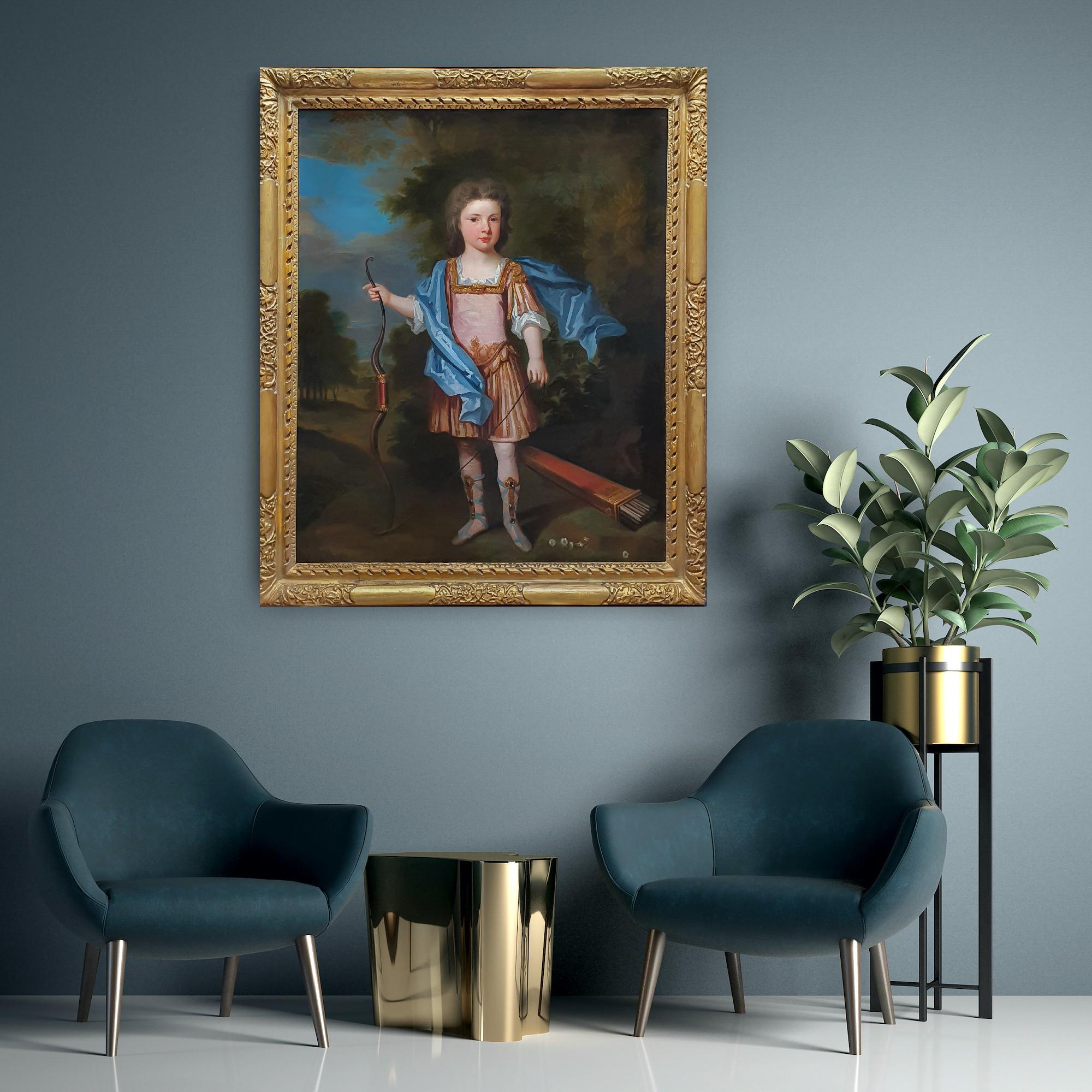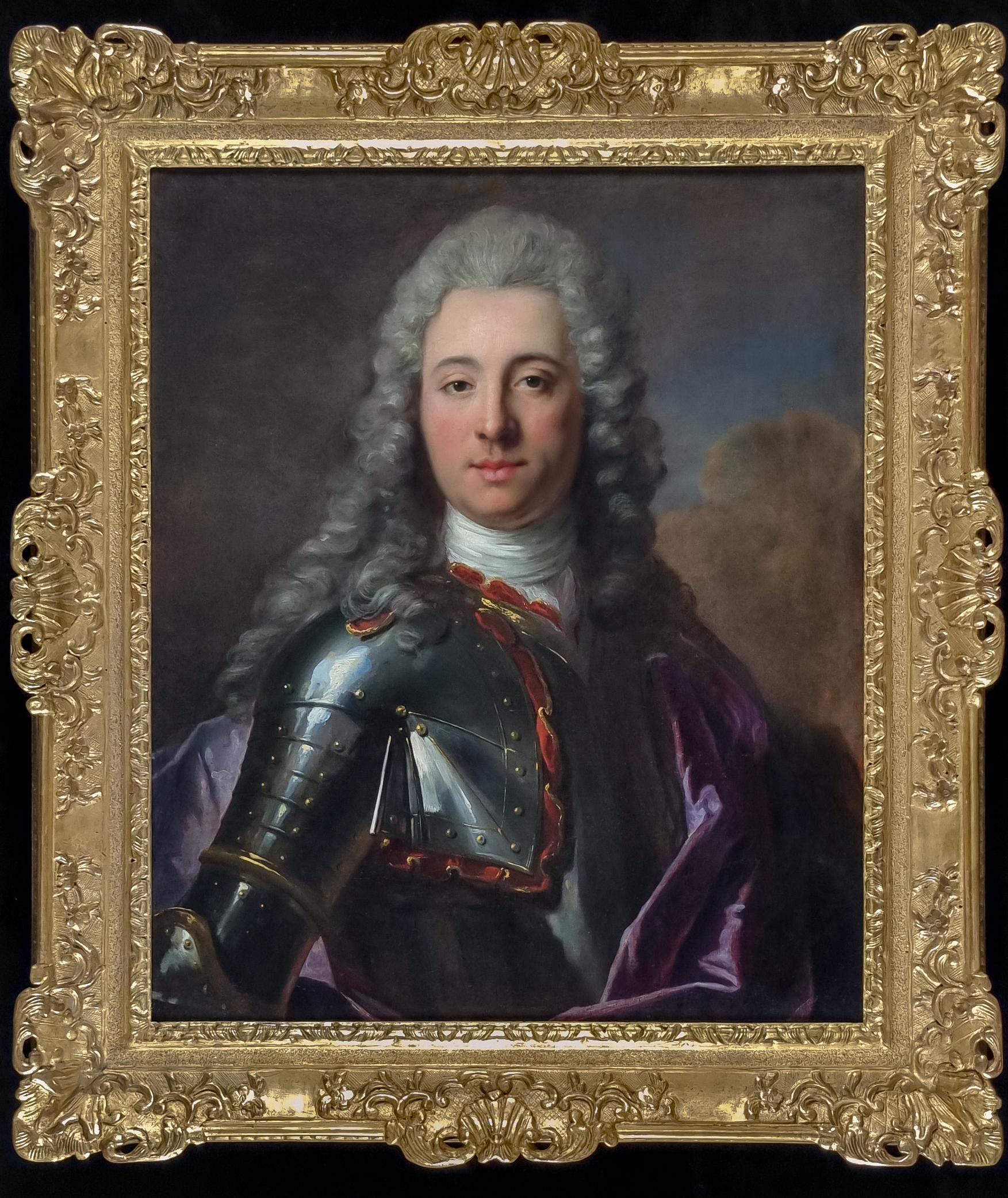Items Similar to Portrait of a Lady in Blue Silk Dress & Crimson Mantle c.1695; by Thomas Murray
Want more images or videos?
Request additional images or videos from the seller
1 of 14
Thomas MurrayPortrait of a Lady in Blue Silk Dress & Crimson Mantle c.1695; by Thomas Murraycirca 1695
circa 1695
About the Item
The sitter is elegantly attired in a blue silk dress over a white frilled chemise and a striking crimson mantle. The artist, Thomas Murray, can be described as one of the most successful and talented during the last part of the seventeenth century. It is not surprising that Murray painted the portraits of King William III, Queen Mary, Queen Ann as well as several other high-ranking individuals. The influence of Sir Godfrey Kneller is evident and even expected considering the importance of Kneller, and even though the formula employed for head and shoulders portraits of woman during the period is similar, Murray’s work is distinguishable by a refined and elegant manner, a smooth overall feel, and often, distinctive eyes. Murray is known to have employed not only the same pattern as our portrait but the three distinctive colours (blue, white, red) many times.
Thomas Murray was born in Scotland but moved to London to study with a member of the De Critz family. Later he was a pupil of the English portraitist John Riley (1646-1691), who was court painter to King William III and Queen Mary, and was practising as a painter on his own in the 1680s. In 1691 he took over Riley’s studio when that artist died in 1691 and he established a very successful practice.
The Rev, James Dalloway accounted that Murray “was remarkable for his personal beauty and for the elegance of his manner” and he was also noted to have been hard working, courteous and popular with his customers. His portraiture retains an individual style and easily recognised but his earlier work is similar to John Closterman, who was a fellow pupil, and many consider this period to be his finest.
Murray invested wisely in property and when he died in 1735, he left around £40,000. He had no children and he bequeathed his money to a nephew with instructions that his monument, with a bust, should be erected in Westminster Abbey, provided that it did not cost too much – but his nephew decided that it was indeed “too expensive” and the plan did not proceed. He is buried in St. Paul's, Covent Garden.
Murray’s work is represented in many British country houses and private collections, the National Portrait Gallery London, Royal Society and Middle Temple in London, and in the Uffizi Gallery in Florence.
A good example of 17th century British portraiture.
Measurements: Height 90cm, Width 77cm framed (Height 35.5”, Width 30.75” framed
- Creator:Thomas Murray (1663 - 1734)
- Creation Year:circa 1695
- Dimensions:Height: 35.44 in (90 cm)Width: 30.32 in (77 cm)Depth: 1.97 in (5 cm)
- Medium:
- Movement & Style:
- Period:
- Condition:The condition is very good and can be hung and enjoyed immediately. The painting has passed a strict condition assessment by a professional conservator prior to going on sale.
- Gallery Location:London, GB
- Reference Number:1stDibs: LU1199113390452
About the Seller
5.0
Vetted Seller
These experienced sellers undergo a comprehensive evaluation by our team of in-house experts.
Established in 1998
1stDibs seller since 2019
31 sales on 1stDibs
Typical response time: 1 hour
- ShippingRetrieving quote...Ships From: London, United Kingdom
- Return PolicyA return for this item may be initiated within 14 days of delivery.
More From This SellerView All
- Portrait of Young Gentleman, Lord George Douglas, Arcadian Landscape c.1710Located in London, GBPortrait of Young Gentleman, Lord George Douglas, in an Arcadian Landscape c.1710 Attributed to Charles D'Agar (1669-1723) Depicted with bow in hand and situated against an Arcadian...Category
18th Century Old Masters Portrait Paintings
MaterialsCanvas, Oil
- Portrait Painting of Lady Mary Capel, Countess of Essex in a Yellow Dress c.1698By Sir Godfrey KnellerLocated in London, GBThis portrait depicts an elegant, aristocratic women wearing a yellow silk dress with white chemise and a red mantle elegantly draped around her body. By tradition the portrait represents Mary Capel, Countess of Essex. Born Lady Mary Bentinck in 1679, she was the daughter of William Bentinck, 1st Earl of Portland, a Dutch and English nobleman who became in an early stage the favourite of stadtholder William, Prince of Orange (the future King of England) and his wife Anne Villiers (died 1688). Lady Mary's maternal grandparents were Sir Edward Villiers and Lady Frances Howard...Category
17th Century Old Masters Portrait Paintings
MaterialsCanvas, Oil
- Portrait of a Lady in a Blue Gown Holding a Sheer Scarf c.1675-85, Oil on canvasBy Kneller GodfreyLocated in London, GBPortrait of a Lady in a Blue Gown Holding a Sheer Scarf c.1675-85 Studio of Sir Godfrey Kneller (1646-1723) Titan Fine Art present this captivating portrait by the leading late seve...Category
17th Century Old Masters Portrait Paintings
MaterialsCanvas, Oil
- Portrait of a Lady in an Elaborate Stone Cartouche, Oil on canvas PaintingBy Mary BealeLocated in London, GBPortrait of a Lady in an Elaborate Stone Cartouche c.1675-80 Mary Beale (1632-1699) Titan Fine Art present this superb portrait where the sitter has been portrayed wearing a low-cut white chemise under a gold silk robe with a draped light...Category
17th Century Old Masters Portrait Paintings
MaterialsCanvas, Oil
- Portrait of Gentleman in Lace Cravat & Armour 1680’s Painting, Fine Carved FrameBy (circle of) Pierre MignardLocated in London, GBTitan Fine Art presents this portrait of a brave and chivalrous character. The gentleman has been depicted in armour, an elaborate full wig, and in accordance with the latest French fashion, an elaborate type of Venetian Gros point lace cravat and large silk bow (also called a cravat-string) – a type that were popular across Europe in the 1680’s. Point lace was fabulously expensive - a cravat was equivalent to six weeks income for a gentleman - and therefore indicative of a wearer's wealth and social class. A nobleman riding onto the battlefield would wear a lace cravat over his armour to demonstrate his status. The attire, along with the coat-of-arms, help to proclaim to every onlooker that the gentleman is a superior being. The depiction of the lace, apart from denoting the wealth of the sitter, was a deliberate way for the artist to demonstrate his own artistic ambition and technical skills Argent seasoned gule with three lozenges sable are those of the Crois family, who were minor nobility, originating from the Boulogne region in the north of France. The fact that the sitter is a high ranking noble excludes him as a member of the Crois family. As is so commonly the case, the coat of arms was a later addition, probably in the nineteenth century, by a family who sought to glorify their pedigree by adding their arms to the portrait. These arms are now an interesting part of the portraits history. The artist has captured a sense of the sitter’s character and the features of the sitter’s face have been rendered with great sensitivity. His confident gaze perhaps reflecting the near invincibility afforded by this steel suit. The work is a very good example of French portraiture from the period. Presented in an exquisite hand-carved and gilded seventeenth century frame - which is an exceptional work of art in itself. Pierre Mignard, known as le Romain, was a French painter of the court of the French King Louis XIV and was, with Charles Le Brun (1619-90), one of the most successful painters during the reign of Louis XIV. After training in Troyes, where he was born, and in Bourges, Mignard joined the studio of Simon Vouet in Paris in 1627. He went to Italy in 1636 and remained there until 1657. He studied the work of Correggio and Pietro da Cortona in Rome as well as copying Annibale Carracci's frescoes in the Palazzo Farnese. On Le Brun's death in 1690 he succeeded him as its Director and as First Painter to the King painting...Category
17th Century Old Masters Portrait Paintings
MaterialsOil, Canvas
- Portrait of a Gentleman in Scarlet Robe Holding Flowers c.1675, Oil on canvasLocated in London, GBTitan Fine Art present this striking portrait, which was painted by one of the most talented artists working in England during the last half of the 17th century, John Greenhill. Gre...Category
17th Century Old Masters Portrait Paintings
MaterialsCanvas, Oil
You May Also Like
- Oil Painting Portrait, attributed to John Vanderbank (1694-1739)By John VanderbankLocated in Uppingham, GBOil Painting Portrait of John Campbell, 4th Duke of Argyll,, att to John Vanderbank (1694-1739) Housed in a swept frame which has been restored after photo. Canvas Size 50" x 40", Fr...Category
1690s Old Masters Portrait Paintings
MaterialsCanvas, Oil
- 18th Century by Pietro Bardellino Mary Magdalene Painting Oil on CanvasBy Pietro BardellinoLocated in Milano, LombardiaPietro Bardellino (Naples, 1731 – Naples, 1806) Mary Magdalene Oil on canvas, cm. 75 x 60 – with frame cm. 97 x 82 Antique shaped and carved wooden frame Publications: unpublished T...Category
Mid-18th Century Old Masters Portrait Paintings
MaterialsCanvas, Oil
- 18th Century By Dalla Rosa Portrait of Angela GuggerottiFracastoro Oil on CanvasLocated in Milano, LombardiaFrame in lacquered and gilded wood. The painting is mentioned in Dizionario Biografico degli Italiani Treccani in the biography of the artist.Category
18th Century Old Masters Portrait Paintings
MaterialsCanvas, Oil
- 17th Century by Giuseppe Assereto Portrait of an Elderly Woman Oil on CanvasBy Giuseppe AsseretoLocated in Milano, LombardiaGiuseppe Assereto (Genova - 1626 ca – Genova 1656/57) Portrait of an elderly woman, possible portrait of Maddalena Massone, wife of Gioacchino Assereto Oil on canvas, cm. 65,5 x 51,5...Category
Early 17th Century Old Masters Portrait Paintings
MaterialsCanvas, Oil
- 19th Century By Giuseppe Molteni Portrait of a Woman Oil on CanvasLocated in Milano, LombardiaBeautiful original frame in gilded wood. Expertise by Prof. Fernando Mazzocca.Category
19th Century Old Masters Portrait Paintings
MaterialsCanvas, Oil
- 17th Century by Juan Alfonso Abril Head of St Paul Painting Oil on CanvasLocated in Milano, LombardiaJuan Alfonso Abril (active in the 17th century in Valladolid) Head of Saint Paul Oil on canvas, cm. 48,5 x 62 - with frame cm. 63 x 76,5 Shaped wooden f...Category
Early 17th Century Old Masters Figurative Paintings
MaterialsCanvas, Oil





